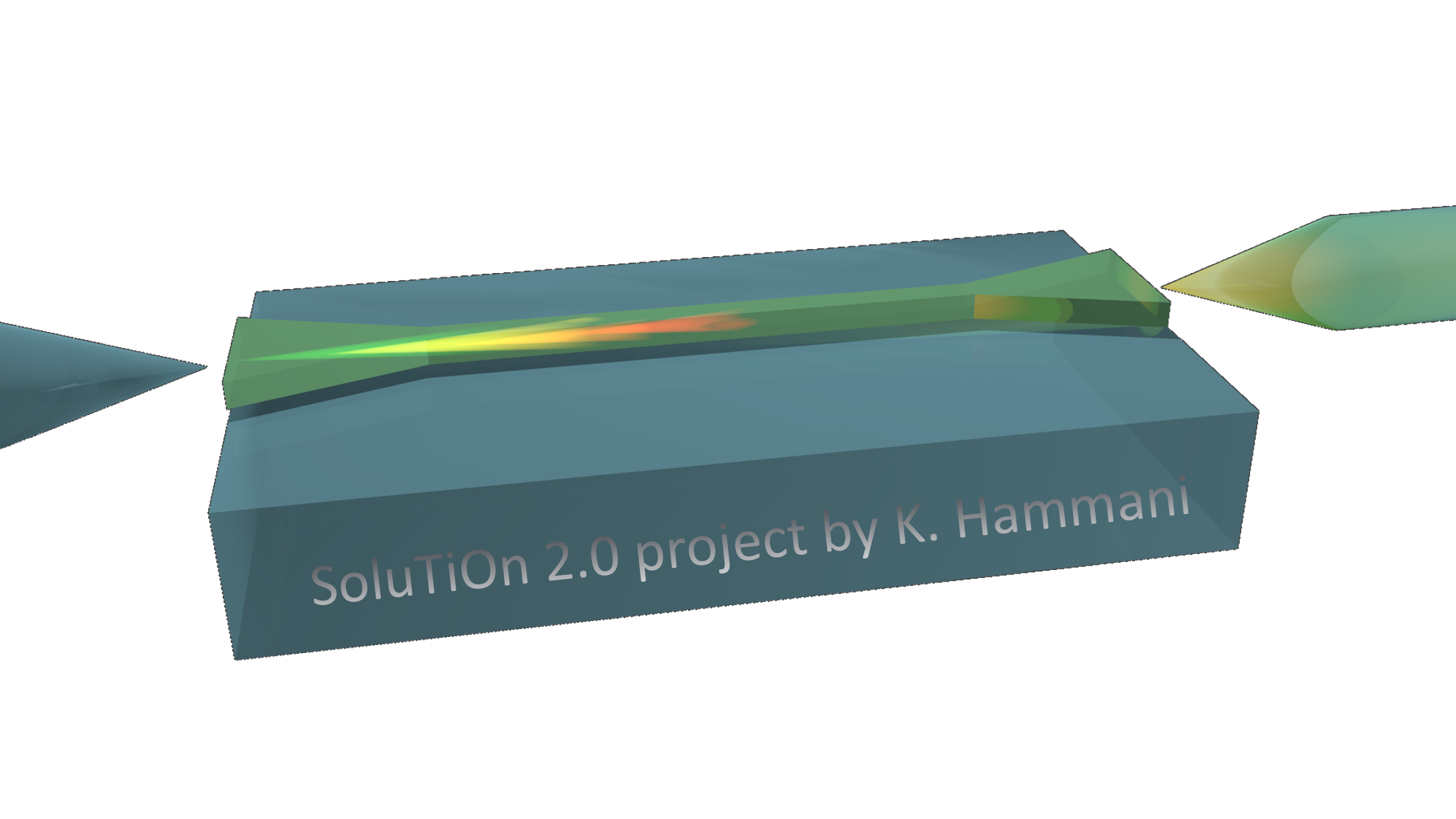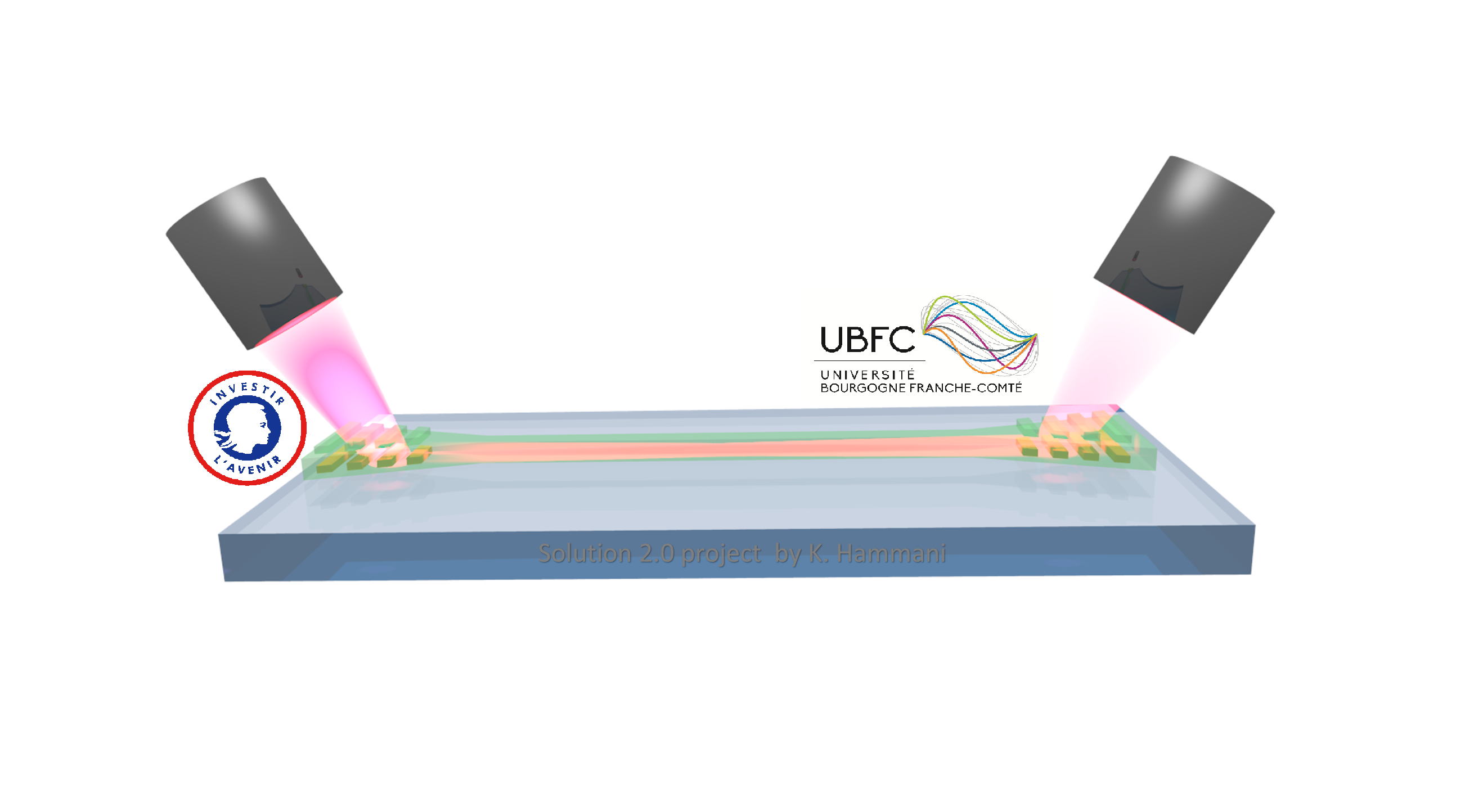Dr. Kamal Hammani (1985), doctorat de Physique (Université de Bourgogne, 2011); post-doc à l’Optoelectronics Research Center de l’Université de Southampton au Royaume-Uni (2012-2013); Maître de Conférences à l'Université de Bourgogne (depuis 2013).
Travaux de recherches (au Laboratoire Interdisciplinaire Carnot de Bourgogne, ICB UMR 6303 CNRS/uB) couvrant l’optique non-linéaire, les télécommunications par fibres optiques, la nanophotonique et la plasmonique en vue d'applications optoélectroniques dans le proche et moyen infrarouge.
en cours
- ANR ELECTRODE (https://anrelectrode.wixsite.com/english)
- Implication dans les projets européens PLasmoniAC et Nebula
terminés
- BQR
- ICB – projet BioDoT
- Implication dans le projet européen PlasmoFab
- European FP7-ICT-2011-7 CLARITY (dévelopement and démonstration de convertisseurs de fréquences ultra-large bande basés sur des nano-guides de silicium et des fibres optiques en verres de tellures, 2011-2014)
- LABEX ACTION (Smart Systems Integrated in Matter, 2012-2020) – porteur du projet INSPIRE
- Région Bourgogne PARI II : PHOTCOM (Photonique & Communications Optiques, 2014-2020).
- Projet ISITE-BFC Junior Fellowship (PI)
Electro-optic frequency combs
Alexandre Parriaux, Kamal Hammani, Guy Millot,Journal : Adv. Opt. Photonics - n° 12 - 2020 - 223-287
Colloidal quantum dots decorated micro-ring resonators for efficient integrated waveguides excitation
Jean-Claude Weeber, Gerard Colas-des-Francs, Alexandre Bouhelier, Aymeric Leray, Kirill Vasilev, Xiao Yu, Kamal Hammani, Juan-Miguel Arocas, Gregory Gadret, Laurent Markey, Benoit Dubertret,Journal : Nanophotonics - n° 9 - 2020 - 1411-1423
A long-range plasmonic optical waveguide corner mirror chip
Laurent Markey, Christian Vernoux, Kamal Hammani, Juan Arocas, Jean-Claude Weeber, Alain Dereux,Journal : Micro. Nano. Eng. - n° 7 - 2020 - 100049
Comparative analysis of stimulated Brillouin scattering at 2 mu m in various infrared glass-based optical fibers
M. Deroh, J-C Beugnot, K. Hammani, C. Finot, J. Fatome, F. Smektala, H. Maillotte, T. Sylvestre, B. Kibler,Journal : J. Opt. Soc. Am. B-Opt. Phys. - n° 37 - 2020 - 3792-3800
Phase evolution of Peregrine-like breathers in optics and hydrodynamics
Gang Xu, Kamal Hammani, Amin Chabchoub, John M. Dudley, Bertrand Kibler, Christophe Finot,Journal : Phys. Rev. E - n° 99 - 2019 - 012207
Silicon Waveguides for High-Speed Optical Transmissions and Parametric Conversion Around 2 mu m
M. Lamy, C. Finot, P. Colman, J. Fatome, G. Millot, G. Roelkens, B. Kuyken, K. Hammani,Journal : IEEE Photonics Technol. Lett. - n° 31 - 2019 - 165-168
Si rich Si nitride waveguides or optical transmissions and toward wavelength conversion around 2 mu m
Manon Lamy, Christophe Finot, Alexandre Parriaux, Cosimo Lacava, Thalia Dominguez Bucio, Frederic Gardes, Guy Millot, Periklis Petropoulos, Kamal Hammani,Journal : Appl. Optics - n° 58 - 2019 - 5165-5169
Applications of sinusoidal phase modulation in temporal optics to highlight some properties of the Fourier transform
K. Hammani, J. Fatome, C. Finot,Journal : Eur. J. Phys. - n° 40 - 2019 - 055301
Electro-optic dual-comb spectrometer in the thulium amplification band for gas sensing applications
Alexandre Parriaux, Kamal Hammani, Guy Millot,Journal : Opt. Lett. - n° 44 - 2019 - 4335-4338
Octave Spanning Supercontinuum in Titanium Dioxide Waveguides
Kamal Hammani, Laurent Markey, Manon Lamy, Bertrand Kibler, Juan Arocas, Julien Fatome, Alain Dereux, Jean-Claude Weeber, Christophe Finot,Journal : Appl. Sci.-Basel - n° 8 - 2018 - 543
Two-micron all-fibered dual-comb spectrometer based on electro-optic modulators and wavelength conversion
Alexandre Parriaux, Kamal Hammani, Guy Millot,Journal : Commun. Phys. - n° 1 - 2018 - 17
Electromigrated electrical optical antennas for transducing electrons and photons at the nanoscale
Arindam Dasgupta, Mickael Buret, Nicolas Cazier, Marie-Maxime Mennemanteuil, Reinaldo Chacon, Kamal Hammani, Jean-Claude Weeber, Juan Arocas, Laurent Markey, Gerard Colas des Francs, Alexander Uskov, Igor Smetanin, Alexandre Bouhelier,Journal : Beilstein J. Nanotechnol. - n° 9 - 2018 - 1964-1976
Nonlinear sculpturing of optical pulses with normally dispersive fiber-based devices
Christophe Finot, Ilya Gukov, Kamal Hammani, Sonia Boscolo,Journal : Opt. Fiber Technol. - n° 45 - 2018 - 306-312
Characterization of CMOS metal based dielectric loaded surface plasmon waveguides at telecom wavelengths
J. -C. Weeber, J. Arocas, O. Heintz, L. Markey, S. Viarbitskaya, G. Colas-des-Francs, K. Hammani, A. Dereux, C. Hoessbacher, U. Koch, J. Leuthold, K. Rohracher, A. L. Giesecke, C. Porschatis, T. Wahlbrink, B. Chmielak, N. Pleros, D. Tsiokos,Journal : Opt. Express - n° 25 - 2017 - 394-408
Demonstration of High-Speed Optical Transmission at 2 mu m in Titanium Dioxide Waveguides
Manon Lamy, Christophe Finot, Julien Fatome, Juan Arocas, Jean-Claude Weeber, Kamal Hammani,Journal : Appl. Sci.-Basel - n° 7 - 2017 - 631
Broadband etching-free metal grating couplers embedded in titanium dioxide waveguides
Manon Lamy, Kamal Hammani, Juan Arocas, Christophe Finot, Jean-Claude Weeber,Journal : Opt. Lett. - n° 42 - 2017 - 2778-2781
Ten gigabit per second optical transmissions at 1.98 mu m in centimetre-long SiGe waveguides
M. Lamy, C. Finot, J. Fatome, M. Brun, P. Labeye, S. Nicolleti, A. Bogris, D. Syvridis, M. A. Ettabib, D. J. Richardson, P. Petropoulos, K. Hammani,Journal : Electron. Lett. - n° 53 - 2017 - 1213-1214
80 GHz waveform generated by the optical Fourier synthesis of four spectral sidebands
Julien Fatome, Kamal Hammani, Bertrand Kibler, Christophe Finot,Journal : Laser Phys. Lett. - n° 13 - 2016 - 015102
Colloidal Quantum Dot Integrated Light Sources for Plasmon Mediated Photonic Waveguide Excitation
Jean-Claude Weeber, Kamal Hammani, Gerard Colas-des-Francs, Alexandre Bouhelier, Juan Arocas, Arunandan Kumar, Fabien Eloi, Stephanie Buil, Xavier Quelin, Jean-Pierre Hermier, Michel Nasilowski, Benoit Dubertret,Journal : ACS Photonics - n° 3 - 2016 - 844-852
Roadmap on optical rogue waves and extreme events
Nail Akhmediev, Bertrand Kibler, Fabio Baronio, Milivoj Belic, Wei-Ping Zhong, Yiqi Zhang, Wonkeun Chang, Jose M. Soto-Crespo, Peter Vouzas, Philippe Grelu, Caroline Lecaplain, K. Hammani, S. Rica, A. Picozzi, Mustapha Tlidi, Krassimir Panajotov, Arnaud Mussot, Abdelkrim Bendahmane, Pascal Szriftgiser, Goery Genty, John Dudley, Alexandre Kudlinski, Ayhan Demircan, Uwe Morgner, Shalva Amiraranashvili, Carsten Bree, Guenter Steinmeyer, C. Masoller, Neil G. R. Broderick, Antoine F. J. Runge, Miro Erkintalo, S. Residori, U. Bortolozzo, F. T. Arecchi, Stefan Wabnitz, C. G. Tiofack, S. Coulibaly, M. Taki,Journal : J. Opt. - n° 18 - 2016 - 063001
Polarization Insensitive Wavelength Conversion in a Low-Birefringence SiGe Waveguide
Mohamed A. Ettabib, Alexandros Kapsalis, Adonis Bogris, Francesca Parmigiani, Victor J. F. Rancano, Kyle Bottrill, Mickael Brun, Pierre Labeye, Sergio Nicoletti, Kamal Hammani, Dimitris Syvridis, David J. Richardson, Periklis Petropoulos,Journal : IEEE Photonics Technol. Lett. - n° 28 - 2016 - 1221-1224
All-optical Phase Regeneration with Record PSA Extinction Ratio in a Low-birefringence Silicon Germanium Waveguide
Mohamed A. Ettabib, Kyle Bottrill, Francesca Parmigiani, Alexandros Kapsalis, Adonis Bogris, Mickael Brun, Pierre Labeye, Sergio Nicoletti, Kamal Hammani, Dimitris Syvridis, David J. Richardson, Periklis Petropoulos,Journal : J. Lightwave Technol. - n° 34 - 2016 - 3993-3998
Broadband telecom to mid-infrared supercontinuum generation in a dispersion-engineered silicon germanium waveguide
Mohamed A. Ettabib, Lin Xu, Adonis Bogris, Alexandros Kapsalis, Mohammad Belal, Emerick Lorent, Pierre Labeye, Sergio Nicoletti, Kamal Hammani, Dimitris Syvridis, David P. Shepherd, Jonathan H. V. Price, David J. Richardson, Periklis Petropoulos,Journal : Opt. Lett. - n° 40 - 2015 - 4118-4121
Towards nonlinear conversion from mid- to near-infrared wavelengths using Silicon Germanium waveguides
Kamal Hammani, Mohamed A. Ettabib, Adonis Bogris, Alexandros Kapsalis, Dimitris Syvridis, Mickael Brun, Pierre Labeye, Sergio Nicoletti, Periklis Petropoulos,Journal : Opt. Express - n° 22 - 2014 - 9667-9674
Pulse transition to similaritons in normally dispersive fibre amplifiers
K. Hammani, S. Boscolo, C. Finot,Journal : J. Opt. - n° 15 - 2013 - 025202
Extreme optical fluctuations in lumped Raman fibre amplifiers
K. Hammani, C. Finot,Journal : J. Opt. - n° 15 - 2013 - 064009
Optical properties of silicon germanium waveguides at telecommunication wavelengths
Kamal Hammani, Mohamed A. Ettabib, Adonis Bogris, Alexandros Kapsalis, Dimitris Syvridis, Mickael Brun, Pierre Labeye, Sergio Nicoletti, David J. Richardson, Periklis Petropoulos,Journal : Opt. Express - n° 21 - 2013 - 16690-16701
FWM-based wavelength conversion of 40 Gbaud PSK signals in a silicon germanium waveguide
Mohamed A. Ettabib, Kamal Hammani, Francesca Parmigiani, Liam Jones, Alexandros Kapsalis, Adonis Bogris, Dimitris Syvridis, Mickael Brun, Pierre Labeye, Sergio Nicoletti, Periklis Petropoulos,Journal : Opt. Express - n° 21 - 2013 - 16683-16689
A comment on "Research on the nonlinear pulse propagation by numerical analysis" by Li and Yin [Optik 12 (13) (2011) 1195-1200]
K. Hammani, C. Finot,Journal : Optik - n° 123 - 2012 - 1805-1806
Experimental signatures of extreme optical fluctuations in lumped Raman fiber amplifiers
Kamal Hammani, Christophe Finot,Journal : Opt. Fiber Technol. - n° 18 - 2012 - 93-100
Nonlinear spectral shaping and optical rogue events in fiber-based systems
Kamal Hammani, Bertrand Kibler, Julien Fatome, Sonia Boscolo, Goery Genty, John M. Dudley, Guy Millot, Christophe Finot,Journal : Opt. Fiber Technol. - n° 18 - 2012 - 248-256
Active reduction of fluctuations in fourth-order modulation instability
K. Hammani, C. Finot, R. Habert, A. Mussot, A. Kudlinski,Journal : Opt. Lett. - n° 37 - 2012 - 4305-4307
Peregrine soliton generation and breakup in standard telecommunications fiber
Kamal Hammani, Bertrand Kibler, Christophe Finot, Philippe Morin, Julien Fatome, John M. Dudley, Guy Millot,Journal : Opt. Lett. - n° 36 - 2011 - 112-114
Extreme statistics in Raman fiber amplifiers: From analytical description to experiments
Kamal Hammani, Antonio Picozzi, Christophe Finot,Journal : Opt. Commun. - n° 284 - 2011 - 2594-2603
Spectral dynamics of modulation instability described using Akhmediev breather theory
K. Hammani, B. Wetzel, B. Kibler, J. Fatome, C. Finot, G. Millot, N. Akhmediev, J. M. Dudley,Journal : Opt. Lett. - n° 36 - 2011 - 2140-2142
Rogue waves, rational solitons and wave turbulence theory
Bertrand Kibler, Kamal Hammani, Claire Michel, Christophe Finot, Antonio Picozzi,Journal : Phys. Lett. A - n° 375 - 2011 - 3149-3155
Effects of fourth-order fiber dispersion on ultrashort parabolic optical pulses in the normal dispersion regime
Brandon G. Bale, Sonia Boscolo, Kamal Hammani, Christophe Finot,Journal : J. Opt. Soc. Am. B-Opt. Phys. - n° 28 - 2011 - 2059-2065
Higher-Order Modulation Instability in Nonlinear Fiber Optics
Miro Erkintalo, Kamal Hammani, Bertrand Kibler, Christophe Finot, Nail Akhmediev, John M. Dudley, Goery Genty,Journal : Phys. Rev. Lett. - n° 107 - 2011 - 253901
Selection of Extreme Events Generated in Raman Fiber Amplifiers Through Spectral Offset Filtering
Christophe Finot, Kamal Hammani, Julien Fatome, John M. Dudley, Guy Millot,Journal : IEEE J. Quantum Electron. - n° 46 - 2010 - 205-213
Emergence of rogue waves from optical turbulence
Kamal Hammani, Bertrand Kibler, Christophe Finot, Antonio Picozzi,Journal : Phys. Lett. A - n° 374 - 2010 - 3585-3589
Emergence of extreme events in fiber-based parametric processes driven by a partially incoherent pump wave
Kamal Hammani, Christophe Finot, Guy Millot,Journal : Opt. Lett. - n° 34 - 2009 - 1138-1140
Soliton Generation and Rogue-Wave-Like Behavior Through Fourth-Order Scalar Modulation Instability
Kamal Hammani, Christophe Finot, Bertrand Kibler, Guy Millot,Journal : IEEE Photonics J. - n° 1 - 2009 - 205-212
Real-time measurement of long parabolic optical similaritons
K. Hammani, C. Finot, S. Pitois, J. Fatome, G. Millot,Journal : Electron. Lett. - n° 44 - 2008 - 1239
Optical rogue-wave-like extreme value fluctuations in fiber Raman amplifiers
Kamal Hammani, Christophe Finot, John. M. Dudley, Guy Millot,Journal : Opt. Express - n° 16 - 2008 - 16467-16474
- Physique Appliquée (BUT 1 SGM)
- Physique des Matériaux (BUT 2 SGM)
- Méthodes Géophysiques (L2)
- Mesures Physiques (L2)
- Electronique Analogique (L3)
En cours
- Responsable de la L1 AGIL en Sciences et Techniques
- Membre du Conseil Scientifique de l'ICB
- Membre du Conseil de Laboratoire (ICB)
- Membre du Conseil du Département de Physique
- Responsable du Module de Mesures Physiques en L2
- Responsable des TP d'Electronique Analogique (L3)
Anciennement
- Directeur Adjoint du Département de Physique
- Membre de la Commission de Proposition (Section 28-29-30)
- Responsable des TP « Expériences d’Optique » (M1)
- Responsable des TP de Biophysique (L2)
Dr. Kamal Hammani was born in 1985.
He received the PhD degree at the University of Burgundy in 2011. Then He went as a post-doctoral research fellow at the Optoelectronics Research Center (University of Southampton) in United-Kingdom (2012-2013).
Since September 2013, he is an Assistant professor at the University of Burgundy.
His Research (at ICB UMR 6303 CNRS/uB) covers nonlinear optics, optical communication, optical fibers, nanophotonics and plasmonics for applications in opto-electronics in near- and mid- infrared.
More precisely, our research activities are mainly based on integrated waveguides.
Our aim is to develop a new platform based on Titanium dioxide (as a nonlinear material) for supercontinuum generation and the related applications.
Research activities
Telecoms at 2 µm
Nowadays, the communication traffic is inexorably increasing and the growing fiber-to-the-home (FTTH) deployment as well as the demand of high definition video content will not stop this trend. Unfortunately, it seems that we are reaching soon a 'capacity crunch'. To prevent it, radical approaches have to be adopted. The two best candidates are the space division multiplexing and the emergence of a new spectral band. The favorite band is around 2 µm thanks to the large amplification band of Thulium. It is likely that the interest for the 2 µm wavelength band increases because it seems to be the perfect candidate for the convergence of fibers, photonics and plasmonics.
We are currently working on telecommunications at 2 µm. We explore the transmission of high bit-rate signal into subwavelength waveguides. Several material are considered as TiO2, SiGe, Si or SiN. First demonstrations have been recently published (see links). An (Open Access) interview is avalaible here.
Titanium Dioxide and new emerging materials
The emergence of 2 µm band will never replace the existing telecommunications bands. Therefore, we are interested in an alternative platform that could be make bridges between all bands from the interconnects band at 850 nm to standard telecommunication band at 1.55 µm passing through the band at 1.310 µm. This is why we focus our attention on the titanium dioxide that is transparent from the visible to the Mid-infrared with negligible two-photon absorption. This platform will be benchmarked by comparison with already used platform (SOI, Silicon nitride, silicon Germanium).
The titanium dioxide (TiO2) is a low cost material compared to III-V semiconductors. It handles high power intensities and is non-toxic compared to chalcogenide glasses. It is transparent from the visible to the mid-infrared wavelength of interest in our project. Regarding the nonlinearity, we can expect at least 30 times better than silica . Moreover, it presents no TPA at standard telecommunications wavelength. This is why we believe that the titanium dioxide represents the perfect candidate for the next generation of telecommunication and all-optical processing.
We have recently shown that the ease of fabrication allows new kind of grating couplers. We have also demonstrated for the first time an octave-spanning supercontinuum generation in such waveguides
Hybrid Plasmonics
The ohmic losses are lower at higher wavelength (2µm) in such a way that surface plasmon polariton (SPP) has longer propagation length. This length stays too low to expect efficient nonlinear effect required for nonlinear all-optical processing. This is why we work on hybrid waveguides that could take advantage of SPP confinement features.
More specifically, we are interested in CMOS plasmonics and in the use of colloidal quantum dots (in the visible).
Dual-Comb Spectroscopy
We are mainly interested in eletroc-optically generated combs at 2 µm and more recently on the conversion towards Mid-IR
Projects
ANR Project n° ANR-21-CE24-0010-01 (https://anrelectrode.wixsite.com/english/about)
ELECTRODE proposes to explore such highly nonlinear and dispersion engineered hybrid waveguides based mainly on two alternative materials, namely silicon-rich nitride and titanium dioxide. For the first time, this project considers thoroughly the titanium dioxide as an alternative platform for nonlinear integrated devices and particularly in the context of multi-octave supercontinuum generation.
Unfortunately, as in the case of optical fibers, it is necessary to specifically design a waveguide for a targeted application. Once manufactured, it is, in principle, difficult to adapt the dispersive properties. ELECTRODE will investigate, for the first time, the possibility of reconfiguring dispersive properties post-fabrication thanks to the thermo-optical properties of the considered materials.
This project will explore the limits of knowledge by focusing on modulated width waveguides also called dispersion oscillating waveguides. This project, which contains a large numerical part as well as advanced fabrication aspects and proof of principle, is also intended to be applied.
Solution 2.0 proposes a set of functions or devices based on nonlinearity or on thermo-optic effect working in any telecommunications band. For the first time, this project considers thoroughly the 2 µm waveband in the context of integrated devices for telecommunications and introduces a new photonic material almost unexplored in such a context: the titanium dioxide (TiO2).

This project is supported by the French “Investissements d’Avenir” program, project ISITE-BFC (contract ANR-15-IDEX-0003).
Unsuccessful ERC Starting Grant submission!

- statut_ub:
- batiment:
- equipe_1:
- OCS
- fonction_equipe_1:
- Agent(e) de service
- mots_cles:
- adresse:
- onglets:
- {tab=Carrière} # {tab=Projets} # {tab=Publications} # {tab=Communications} # {tab=Enseignements} # {tab=Administration} # {/tabs}
- telephone:
- (03.80.39.) 59.04
- e-mail:
- kamal.hammani@u-bourgogne.fr
- site_web:
- departement:
- a:1:{i:0;s:10:"Photonique";}
- fonction:
- Maître de Conférences - CNU Section 30
- localisation:
- UFR Sciences et Techniques, Batiment Mirande (Dijon), Aile D, Bureau DR11A
- texte_onglets:
- [tabs]
[tab title=Carrière]
Dr. Kamal Hammani (1985), doctorat de Physique (Université de Bourgogne, 2011); post-doc à l’Optoelectronics Research Center de l’Université de Southampton au Royaume-Uni (2012-2013); Maître de Conférences à l'Université de Bourgogne (depuis 2013).
Travaux de recherches (au Laboratoire Interdisciplinaire Carnot de Bourgogne, ICB UMR 6303 CNRS/uB) couvrant l’optique non-linéaire, les télécommunications par fibres optiques, la nanophotonique et la plasmonique en vue d'applications optoélectroniques dans le proche et moyen infrarouge.
 [/tab]
[tab title=Projets]
[/tab]
[tab title=Projets]
en cours
- Projet ISITE-BFC Junior Fellowship (PI) : SoluTiOn 2.0
- Région Bourgogne PARI II : PHOTCOM (Photonique & Communications Optiques, 2014-2020).
terminés
- BQR ICB - projet BioDoT
- Implication dans le projet européen PlasmoFab
- European FP7-ICT-2011-7 CLARITY (dévelopement and démonstration de convertisseurs de fréquences ultra-large bande basés sur des nano-guides de silicium et des fibres optiques en verres de tellures, 2011-2014)
- LABEX ACTION (Smart Systems Integrated in Matter, 2012-2020) – porteur du projet INSPIRE
- Physique Générale (IUT & L2)
- Préparation au concours B – Physique (L2 & L3)
- Mesures Physiques (L2)
- Electronique Analogique (L3)
- Expériences d’Optique (IUT SGM 2eme année)
- Directeur Adjoint du Département de Physique
- Membre du Conseil de Laboratoire (ICB)
- Membre de la Commission de Proposition (Section 28-29-30)
- Membre du Conseil du Département de Physique
- Responsable du Module de Mesures Physiques en L2
- Responsable des TP d'Electronique Analogique (L3)
- Responsable des TP "Expériences d’Optique" (M1)
- Responsable des TP de Biophysique (L2)
- Porteur du Projet "Led: Année de la Lumière 2015 en Bourgogne
- carriere:
- Dr. Kamal Hammani (1985), doctorat de Physique (Université de Bourgogne, 2011); post-doc à l’Optoelectronics Research Center de l’Université de Southampton au Royaume-Uni (2012-2013); Maître de Conférences à l'Université de Bourgogne (depuis 2013).
Travaux de recherches (au Laboratoire Interdisciplinaire Carnot de Bourgogne, ICB UMR 6303 CNRS/uB) couvrant l’optique non-linéaire, les télécommunications par fibres optiques, la nanophotonique et la plasmonique en vue d'applications optoélectroniques dans le proche et moyen infrarouge.

- projets:
en cours
- Projet IANR ELECTRODE
terminés
- Projet ISITE-BFC Junior Fellowship (PI) : SoluTiOn 2.0
- Région Bourgogne PARI II : PHOTCOM (Photonique & Communications Optiques, 2014-2020).
- BQR ICB - projet BioDoT
- Implication dans le projet européen PlasmoFab
- European FP7-ICT-2011-7 CLARITY (dévelopement and démonstration de convertisseurs de fréquences ultra-large bande basés sur des nano-guides de silicium et des fibres optiques en verres de tellures, 2011-2014)
- LABEX ACTION (Smart Systems Integrated in Matter, 2012-2020) – porteur du projet INSPIRE
- communications:
- publications:
- Lire ses publications [iframe src="https://icb.u-bourgogne.fr/publications/membres/HAMMANI_Kamal.html" width="100%" height="500"]
- enseignements:
- Physique Appliquée (BUT 1 SGM)
- Physique des Matériaux (BUT 2 SGM)
- Méthodes Géophysiques (L2)
- Mesures Physiques (L2)
- Electronique Analogique (L3)
- administration:
- en cours
- Directeur Adjoint du Département de Physique
- Membre du Conseil de Laboratoire (ICB)
- Membre de la Commission de Proposition (Section 28-29-30)
- Membre du Conseil du Département de Physique
- Responsable du Module de Mesures Physiques en L2
- Responsable des TP d'Electronique Analogique (L3)
- Responsable des TP "Expériences d’Optique" (M1)
- Responsable des TP de Biophysique (L2)
- Porteur du Projet "Led: Année de la Lumière 2015 en Bourgogne
- kc_data:
- a:8:{i:0;s:0:"";s:4:"mode";s:2:"kc";s:3:"css";s:0:"";s:9:"max_width";s:0:"";s:7:"classes";s:0:"";s:9:"thumbnail";s:0:"";s:9:"collapsed";s:0:"";s:9:"optimized";s:0:"";}
- switch:
- 1
- kc_raw_content:
- [kc_row use_container="yes" _id="220814"][kc_column width="12/12" video_mute="no" _id="632444"][kc_tabs speed="450" pagination="yes" active_section="1" _id="318479"][kc_tab title="Carrière" _id="863599"][kc_column_text _id="214216"]
Dr. Kamal Hammani (1985), doctorat de Physique (Université de Bourgogne, 2011); post-doc à l’Optoelectronics Research Center de l’Université de Southampton au Royaume-Uni (2012-2013); Maître de Conférences à l'Université de Bourgogne (depuis 2013).
[/kc_column_text][/kc_tab][kc_tab title="Projets" _id="623587"][kc_column_text _id="477616"]
Travaux de recherches (au Laboratoire Interdisciplinaire Carnot de Bourgogne, ICB UMR 6303 CNRS/uB) couvrant l’optique non-linéaire, les télécommunications par fibres optiques, la nanophotonique et la plasmonique en vue d'applications optoélectroniques dans le proche et moyen infrarouge.en cours
- ANR ELECTRODE (https://anrelectrode.wixsite.com/english)
- Implication dans les projets européens PLasmoniAC et Nebula
terminés
- BQR
- ICB - projet BioDoT
- Implication dans le projet européen PlasmoFab
- European FP7-ICT-2011-7 CLARITY (dévelopement and démonstration de convertisseurs de fréquences ultra-large bande basés sur des nano-guides de silicium et des fibres optiques en verres de tellures, 2011-2014)
- LABEX ACTION (Smart Systems Integrated in Matter, 2012-2020) – porteur du projet INSPIRE
- Région Bourgogne PARI II : PHOTCOM (Photonique & Communications Optiques, 2014-2020).
- Projet ISITE-BFC Junior Fellowship (PI)
- Physique Appliquée (BUT 1 SGM)
- Physique des Matériaux (BUT 2 SGM)
- Méthodes Géophysiques (L2)
- Mesures Physiques (L2)
- Electronique Analogique (L3)
En cours
- Responsable de la L1 AGIL en Sciences et Techniques
- Membre du Conseil Scientifique de l'ICB
- Membre du Conseil de Laboratoire (ICB)
- Membre du Conseil du Département de Physique
- Responsable du Module de Mesures Physiques en L2
- Responsable des TP d'Electronique Analogique (L3)
Anciennement
- Directeur Adjoint du Département de Physique
- Membre de la Commission de Proposition (Section 28-29-30)
- Responsable des TP "Expériences d’Optique" (M1)
- Responsable des TP de Biophysique (L2)
Dr. Kamal Hammani was born in 1985.
He received the PhD degree at the University of Burgundy in 2011. Then He went as a post-doctoral research fellow at the Optoelectronics Research Center (University of Southampton) in United-Kingdom (2012-2013).
Since September 2013, he is an Assistant professor at the University of Burgundy.
His Research (at ICB UMR 6303 CNRS/uB) covers nonlinear optics, optical communication, optical fibers, nanophotonics and plasmonics for applications in opto-electronics in near- and mid- infrared.
More precisely, our research activities are mainly based on integrated waveguides.
Our aim is to develop a new platform based on Titanium dioxide (as a nonlinear material) for supercontinuum generation and the related applications.
[/kc_column_text][/kc_tab][/kc_tabs][kc_spacing height="20" _id="410822"][/kc_column][/kc_row][kc_row use_container="yes" _id="407229"][kc_column width="20%" video_mute="no" _id="796870"][kc_single_image image_size="600x300" _id="74996" image_source="media_library" image="11591" on_click_action="open_custom_link" custom_link="https://scholar.google.fr/citations?user=6CVST50AAAAJ|https://scholar.google.fr/citations?user=6CVST50AAAAJ|_blank"][/kc_column][kc_column width="20%" video_mute="no" _id="709160"][kc_raw_code code="PHNwYW4gaWQ9ImJhZGdlQ29udDIwMSI+PHNjcmlwdCB0eXBlPSJ0ZXh0L2phdmFzY3JpcHQiIHNyYz0iaHR0cHM6Ly9wdWJsb25zLmNvbS9tYXNobGV0cz9lbD1iYWRnZUNvbnQyMDEmcmlkPUEtMjA1My0yMDEwIj48L3NjcmlwdD48L3NwYW4+" _id="248410"][/kc_column][kc_column width="20%" video_mute="no" _id="801836"][kc_single_image image_size="600x300" custom_link="https://cv.archives-ouvertes.fr/kamal-hammani|https://cv.archives-ouvertes.fr/kamal-hammani|_blank" _id="358598" image="14150" image_source="media_library" on_click_action="open_custom_link"][/kc_column][kc_column width="20%" video_mute="no" _id="741338"][/kc_column][kc_column width="20%" video_mute="no" _id="785916"][/kc_column][/kc_row][kc_row _id="603193" cols_gap="{`kc-css`:{}}" use_container="yes" force="__empty__" container_class="full bg-rs"][kc_column width="12/12" video_mute="no" _id="497881"][kc_column_text _id="113938"]
Research activities
[/kc_column_text][kc_accordion _id="98618"][kc_accordion_tab title="Telecoms at 2 µm" _id="281816"][kc_column_text _id="164233"]
Nowadays, the communication traffic is inexorably increasing and the growing fiber-to-the-home (FTTH) deployment as well as the demand of high definition video content will not stop this trend. Unfortunately, it seems that we are reaching soon a 'capacity crunch'. To prevent it, radical approaches have to be adopted. The two best candidates are the space division multiplexing and the emergence of a new spectral band. The favorite band is around 2 µm thanks to the large amplification band of Thulium. It is likely that the interest for the 2 µm wavelength band increases because it seems to be the perfect candidate for the convergence of fibers, photonics and plasmonics.
We are currently working on telecommunications at 2 µm. We explore the transmission of high bit-rate signal into subwavelength waveguides. Several material are considered as TiO2, SiGe, Si or SiN. First demonstrations have been recently published (see links). An (Open Access) interview is avalaible here.
[/kc_column_text][/kc_accordion_tab][kc_accordion_tab title="Titanium Dioxide and new emerging materials" _id="773911"][kc_column_text _id="553686"]
The emergence of 2 µm band will never replace the existing telecommunications bands. Therefore, we are interested in an alternative platform that could be make bridges between all bands from the interconnects band at 850 nm to standard telecommunication band at 1.55 µm passing through the band at 1.310 µm. This is why we focus our attention on the titanium dioxide that is transparent from the visible to the Mid-infrared with negligible two-photon absorption. This platform will be benchmarked by comparison with already used platform (SOI, Silicon nitride, silicon Germanium).
The titanium dioxide (TiO2) is a low cost material compared to III-V semiconductors. It handles high power intensities and is non-toxic compared to chalcogenide glasses. It is transparent from the visible to the mid-infrared wavelength of interest in our project. Regarding the nonlinearity, we can expect at least 30 times better than silica . Moreover, it presents no TPA at standard telecommunications wavelength. This is why we believe that the titanium dioxide represents the perfect candidate for the next generation of telecommunication and all-optical processing.
We have recently shown that the ease of fabrication allows new kind of grating couplers. We have also demonstrated for the first time an octave-spanning supercontinuum generation in such waveguides
[/kc_column_text][/kc_accordion_tab][kc_accordion_tab title="Hybrid Plasmonics" _id="907787"][kc_column_text _id="852608"]
The ohmic losses are lower at higher wavelength (2µm) in such a way that surface plasmon polariton (SPP) has longer propagation length. This length stays too low to expect efficient nonlinear effect required for nonlinear all-optical processing. This is why we work on hybrid waveguides that could take advantage of SPP confinement features.
More specifically, we are interested in CMOS plasmonics and in the use of colloidal quantum dots (in the visible).
[/kc_column_text][/kc_accordion_tab][kc_accordion_tab title="Dual-Comb Spectroscopy" _id="53720"][kc_column_text _id="185591"]
We are mainly interested in eletroc-optically generated combs at 2 µm and more recently on the conversion towards Mid-IR
[/kc_column_text][/kc_accordion_tab][/kc_accordion][kc_spacing height="20" _id="938370"][/kc_column][/kc_row][kc_row _id="975214"][kc_column width="12/12" video_mute="no" _id="237199"][kc_column_text _id="155860"]
Projects
[/kc_column_text][kc_tabs speed="450" pagination="yes" active_section="1" _id="674473"][kc_tab title="ELECTRODE" _id="517827"][kc_column_text _id="460216"]
ANR Project n° ANR-21-CE24-0010-01 (https://anrelectrode.wixsite.com/english/about)
[/kc_column_text][/kc_tab][kc_tab title="SoluTiOn 2.0 (ISITE BFC)" _id="60397"][kc_column_text _id="123781"]ELECTRODE proposes to explore such highly nonlinear and dispersion engineered hybrid waveguides based mainly on two alternative materials, namely silicon-rich nitride and titanium dioxide. For the first time, this project considers thoroughly the titanium dioxide as an alternative platform for nonlinear integrated devices and particularly in the context of multi-octave supercontinuum generation.
Unfortunately, as in the case of optical fibers, it is necessary to specifically design a waveguide for a targeted application. Once manufactured, it is, in principle, difficult to adapt the dispersive properties. ELECTRODE will investigate, for the first time, the possibility of reconfiguring dispersive properties post-fabrication thanks to the thermo-optical properties of the considered materials.
This project will explore the limits of knowledge by focusing on modulated width waveguides also called dispersion oscillating waveguides. This project, which contains a large numerical part as well as advanced fabrication aspects and proof of principle, is also intended to be applied.
Solution 2.0 proposes a set of functions or devices based on nonlinearity or on thermo-optic effect working in any telecommunications band. For the first time, this project considers thoroughly the 2 µm waveband in the context of integrated devices for telecommunications and introduces a new photonic material almost unexplored in such a context: the titanium dioxide (TiO2).

This project is supported by the French “Investissements d’Avenir” program, project ISITE-BFC (contract ANR-15-IDEX-0003).
[/kc_column_text][/kc_tab][kc_tab title="PlasmoFab" _id="5623"][kc_column_text _id="854135"]
Find out more on: PlasmoFab

[/kc_column_text][kc_video_play video_link="https://www.youtube.com/watch?v=0bAszCXUOag" video_mute="__empty__" video_width="600" loop="yes" control="yes" related="__empty__" showinfo="__empty__" _id="183655" source="youtube"][/kc_tab][kc_tab title="FOCUS" _id="784893"][kc_column_text _id="722512"]
Unsuccessful ERC Starting Grant submission!

[/kc_column_text][/kc_tab][/kc_tabs][/kc_column][/kc_row][kc_row _id="259039"][kc_column width="12/12" video_mute="no" _id="814294"][kc_spacing height="20" _id="916677"][kc_column_text _id="369776"]
Animations / Pictures / Videos
[/kc_column_text][kc_carousel_images img_size="1400x500" items_number="3" tablet="2" mobile="1" speed="500" pagination="yes" auto_play="yes" delay="8" alt_text="__empty__" _id="77378" images="14110,14109,14108,14107" onclick="custom_link" custom_links="aHR0cHM6Ly93d3cubWRwaS5jb20vMjA3Ni0zNDE3LzgvNC81NDMNCmh0dHBzOi8vd3d3Lm1kcGkuY29tLzIwNzYtMzQxNy84LzQvNTQzDQpodHRwczovL3d3dy5vc2FwdWJsaXNoaW5nLm9yZy9vbC9hYnN0cmFjdC5jZm0/dXJpPW9sLTQyLTE0LTI3NzgNCmh0dHBzOi8vd3d3Lm1kcGkuY29tLzIwNzYtMzQxNy83LzYvNjMx" custom_links_target="_blank"][kc_video_play video_link="https://youtu.be/h8KFRpKMhSw" video_mute="__empty__" video_width="600" loop="yes" control="yes" related="__empty__" showinfo="__empty__" _id="675385" source="youtube"][/kc_column][/kc_row][kc_row _id="373227"][kc_column width="12/12" video_mute="no" _id="382474"][kc_column_text _id="61783"]
[/kc_column_text][/kc_column][/kc_row] - ANR ELECTRODE (https://anrelectrode.wixsite.com/english)






